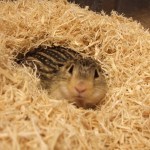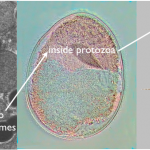mitochondria
Mitochondria produce more than just ATP
Anatomy of a mitochondrion from Wikimedia Commons
Pinchas Cohen from the University of California - Davis presented data showing that mitochondria produce more than just ATP. They also make several peptides that can each affect our physiology. Some help cells respond to insulin better, some help with weight, some regulate cell metabolism. What is even more impressive is that some of these peptides have been shown to slow down the development of atherosclerosis or Alzheimer's, and some even help prevent side effects from chemotherapy in animals. Maybe…
Congratulations to Mallory Ballinger, a graduate student from the University of Minnesota-Duluth, who is the 2015 recipient of the Dr. Dolittle Travel Award! The purpose of this award is to recognize an outstanding graduate student or postdoctoral fellow involved in comparative and evolutionary research and to provide assistance for them to attend the annual American Physiological Society Experimental Biology meeting. The application process includes the submission of a blog entry based on their research. She will be presenting her research at the upcoming Experimental Biology…
Dr. Dolittle spent a few days at the Experimental Biology meeting of the American Physiological Society, learning incredible facts about animal adaptability. In the Sunday session, researchers showed that metabolic byproducts called ketones can protect against seizures caused by hyperbaric oxygen therapy, while seal pups, who fast for up to three months once weaned, increase their insulin resistance and become effectively diabetic. Monday taught us that insects lack lungs, instead exchanging gas through tiny valves called spiracles along their abdomen, while a Burmese python, after eating a…
Mitochondria are cool, important, and fascinating. You know the basic story. Mitochondria are the result of endosymbiosis. A bacterim or bacteria-like organism insinuated itself into another bacterium or bacteria-like organism. The former was small, the latter large. A relationship started up whereby the smaller one became an organelle in the larger one, and Eukaryotic life was formed. You probably also know that in multi-celled organisms mitochondria may be passed on by one sex (female) so paleogenetic research can sort out female lineages by looking only at the DNA found in the…
My two great thesis project loves are hydrogen and symbiosis, and as such, the recent news of a multicellular organism that lives in a completely oxygen free environment and gets its energy from hydrogenosomes instead of mitochondria is totally fascinating.
Hydrogenosomes are organelles that are evolutionarily related to mitochondria. Mitochondria generate energy for the cell by transferring electrons pulled off of sugars molecules to oxygen (this is why we breathe oxygen). The energy from this electron motion is transferred to the production of ATP, the energy currency of the cell, through…
The Not Exactly Pocket Science experiment continues after the vast majority of people who commented liked the pilot post. I'm really enjoying this, for quite unexpected reasons. It's forcing me to flex writing muscles that usually don't get much of a workout. Writing short pieces means being far more economical with language and detail than usual. It means packing in as much information as possible while still keeping things readable. And it means blitz-reading papers and writing quickly without losing any accuracy.
One quick note before the good stuff: last time, a few people suggested that…
At first glance, the African elephant doesn't look like it has much in common with us humans. We support around 70-80 kg of weight on two legs, while it carries around four to six tonnes on four. We grasp objects with opposable thumbs, while it uses its trunk. We need axes and chainsaws to knock down a tree, but it can just use its head. Yet among these differences, there is common ground. We're both long-lived animals with rich social lives. And we have very, very large brains (well, mostly).
But all that intelligence doesn't come cheaply. Large brains are gas-guzzling organs and they need…
I got my copy of "A short guide to the human genome" by Stewart Scherer today from Cold Spring Harbor Laboratory Press (2008, ISBN 978-087969791-4). Usually, I would wait until after I've read a book to write a review, but this book doesn't require that kind of study. As soon I skimmed through it and read some of the questions and answers, I knew this would be the kind of quick reference that I would like to have sitting above my desk.
Scherer has compiled a wonderful text that not only answers many of the kinds of questions that I can think to ask about the human genome, but the kinds of…
You can find out. Blaine Bettinger, the Genetic Genealogist has a fun little quiz.
As many of you know, I'm a big fan of do-it-yourself biology. Digital biology, the field that I write about, is particularly well-suited to this kind of fun and exploration.
Last week, I wrote some instructions for making a phylogenetic tree from mitochondrial genomes. This week, we'll continue our analysis.
I wrote this activity, in part, because of this awful handout that my oldest daughter brought home last year. She presented me with an overly photocopied paper that showed several protein sequences from cytochrome C in several creatures. She said she was supposed count the…
Students at Soldan International High School are participating in an amazing experiment and breaking ground that most science teachers fear to tread.
Soldan students, along with hundreds of thousands of other people, are participating in the National Geographic's Genographic Project. Through this project, students send in cheek swabs, DNA is isolated from the cheek cells, and genetic markers are used to look at ancestry.
Genetic markers in the mitochondrial DNA are used to trace ancestry through the maternal line and markers on the Y chromosome can be used to learn about one's father.…
Last year I wrote about an experiment where I compared a human mitochondrial DNA sequence to primate sequences in the GenBank. Since I wanted to know about the differences between humans, gorillas, and chimps, I used the Entrez query 'Great Apes' to limit my search to a set of sequences in the PopSet database that contained gorillas, bonobos, chimps, and human DNA.
A week ago, I tried to repeat this experiment and...
It didn't work.
All I saw were human mitochondrial sequences. I know the other sequences match, but I didn't see them since there are so many human sequences that…
If we compare sections 1, 2, and 3, we see that section 2 matches very well in a number of different samples, and that there are differences between the sequences in sections 1 and 3.
We also learn something about the people who did the experiment.
At first it appears somewhat odd that there are many matching sequences that are all shorter than the genome and all the same length.
What's up with that?
It turns out that information doesn't have anything to do with the fraction of the genome that matches our query. These short segments are PCR products. They're the same size because the PCR…
Like biology, all bioinformatics is based on the idea that living things shared a common ancestor. I have posted, and will post other articles that test that notion, but for the moment, we're going to use that idea as a starting point in today's quest.
If we agree that we have a common ancestor, then we can use that idea as a basis to ask some interesting questions about our genomes. For, example, we know that genomes change over time - we've looked at single nucleotide changes here and here, and we've seen that large chunks of DNA can move around here.
So, it's interesting to consider…
During these past couple of weeks, we've been comparing mitochondrial DNA sequences from humans and great apes, in order to see how similar the sequences are.
Last week, I got distracted by finding a copy of a human mitochondrial genome, that somehow got out of a mitochondria, and got stuck right inside of chromosome 17! The existence of this extra mitochondrial sequence probably complicates some genetic analyses. One of my readers also asked an interesting question about whether apes have a similar mitochondrial sequence in their equivalent of chromosome 17, and how it compares. We will…
Last week, we decided to compare a human mitochondrial DNA sequence with the mitochondrial sequences of our cousins, the apes, and find out how similar these sequences really are.
The answer is: really, really, similar.
And you can see that, in the BLAST graph, below the fold.
A quick glance shows that the ape with the most similar mitochondrial sequence is Pan paniscus, the pigmy chimpanzee. Next, is Pan troglodytes, the chimp that we see in movies, and last we have Gorilla gorilla.
Then we have a really curious, and unexpected, matching sequence.
Click the picture to see a larger…
We've had a good time in the past few last weeks, identifying unknown sequences and learning our way around a GenBank nucleotide record. To some people, it seems that this is all there is to doing digital biology. They would, of course, be wrong.
We can do much, much more than identifying DNA sequences and obtaining crucial information, like who left their DNA behind on that little blue dress.
Today, we're going to a deeper question about who we are and who are our relatives.
Drumroll, okay, here it comes:
How similar are DNA sequences between humans and apes?
Your assignment is to find…
What do genetic testing and genealogy have in common?
The easy answer is that they're both used by people who are trying to find out who they are, in more ways than one.
Another answer is that both tests can involve DNA sequence data.
And that leads us to another question. If the sequence of my mitochondrial DNA is only two bases different from Cleopatra's, am I really a distant relative? And how do I really even know that my mitochondrial DNA is only two bases different in the first place? What does having a DNA sequence really mean?
Students sequencing mitochondrial DNA
I wrote earlier…



